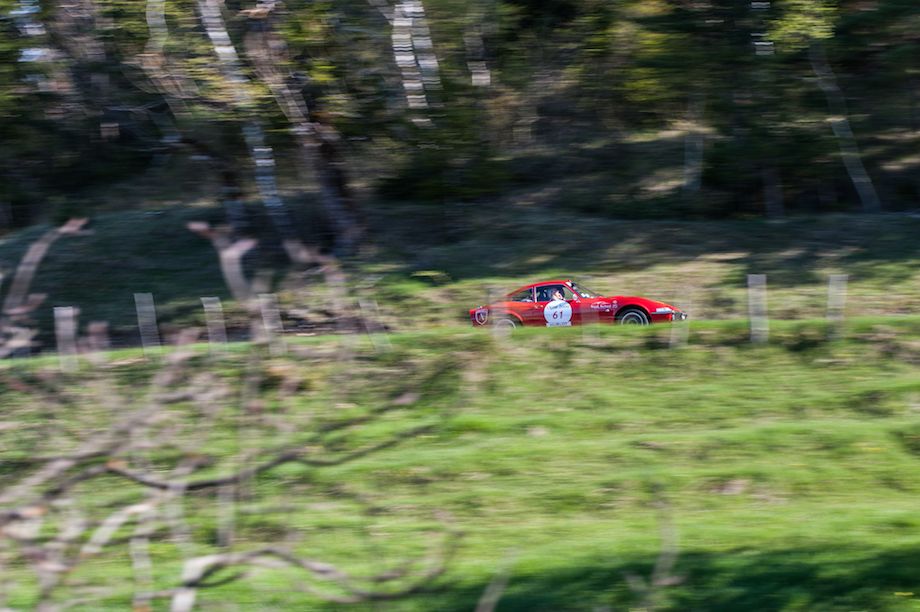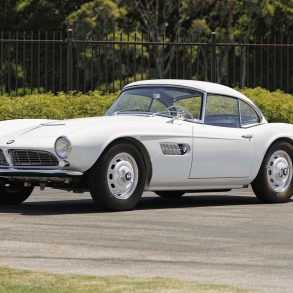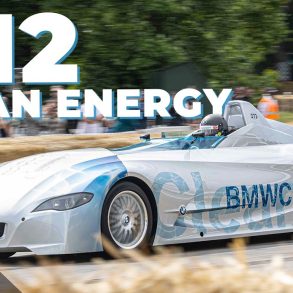If you ask a hardcore BMW enthusiast about their favorite Batmobile, chances are you’re not going to get any answer even remotely related to Gotham’s caped crusader and his set of wheels. On the contrary, it’ll be the BMW 3.0 CSL.
This performance coupé from the 1970s was a touring car superstar and the heroic piece of machinery which put BMW back among the all-time racing greats. The 3.0 CSL is also, by a huge margin, the most handsome touring car of its era and a car that paved the way for the first M cars and BMW’s glory that soon followed.
Why is this sleek Bavarian coupé also known as the Batmobile? What was its impact on the motorsport world? You’re here to find out, in our complete story about the BMW 3.0 CSL.
Background
In the years before the Second World War, BMW was an established automaker with a penchant for racing. The BMW 328 was the company’s weapon of choice, winning races in its native Germany and throughout Europe alike. Powered by a 2.0-liter straight-six, the BMW 328 raked up some glorious in-class victories at the Nürburgring and at the RAC Tourist Trophy, followed by the famed 1938 class victory at the Mille Miglia.

The last big win for the 328 was the class triumph at the 24 Hours of Le Mans, but just months later, the Second World War broke out. As you might have guessed, BMW employed its resources towards building aircraft engines, but as Nazi Germany lost the war, the company found itself with its factories in rubbles, slowly getting back on its feet in the late 1940s by resuming production of its motorcycles.
Unlike Mercedes-Benz, BMW didn’t recoup as well in the post-WW2 years. While Benz soon got back on track, BMW was struggling to survive with its dated range of 500 series luxurious limousines. Moreover, what worked for Mercedes-Benz in the uppermost automotive echelon, just didn’t for BMW.

The 300SL Gullwing was an incredible success, yet BMW failed to get a grip on the American market and soon found itself in an even worse position. It was eventually bailed out by Herbert Quandt and started making up for its losses with the likes of BMW Isetta and 600 bubble cars, as well as the rear-engined 700.
The introduction of the Neue Klasse in 1962 broke the dry spell for the company as this expansive range of modern sporty cars soon molded BMW into an affordable performance brand. Finally, BMW could return to its old ways and in the 1960s it was touring car racing, both on the rallies and around the circuits.

Initially, BMW raced the 1800 4-door sedan as 1800 TI/SA and the 1600TI 2-door, where these original sports sedans competed in various circuit and rally events throughout Europe. The introduction of the 2002 and the 2002ti launched the 02 Series into stardom in part due to its phenomenal performance at the tracks.
On the other hand, big coupés were still a weak spot for BMW. Not having fully recovered from the gloriously messy outcome of the 507’s and the 503’s American adventure, BMW tried again in 1962 with Bertone-built 3200CS, but penning a proper grand tourer was still miles away.

The Neue Klasse rebrand brought the 2000CS, a coupe featuring a beautiful side profile, an experimental front fascia and a twin-carbureted M10 four-cylinder engine. This coupé was built by Karmann, an outside contractor primarily known for official Volkswagen Beetle convertibles and its production methods and overall construction of the 3200CS.
Even with twin carbs, the 2000CS was underpowered and even though it entered racing on a small scale, it couldn’t become anything else but an exotic-looking boulevardier.
Still, the elegant character lines of this automobile were a perfect foundation for a new, modern, and hopefully more successful big BMW, the E9 coupé. Lead BMW designer Wilhelm Hoffmeister mated the silhouette of the 2000CS with styling cues from the E3 executive design, extending the wheelbase and overall length to enable the engine bay to accommodate an M30 straight-six, a promising start for a better performing car.
Development of the BMW 3.0 CSL
The E9 coupé took over from the 2000CS in 1968, starting out as the 2800 CS, a suave pillarless cruiser powered by a carbureted 2.8-liter M30 straight-six.
In all honesty, the M30 was no technological marvel of an engine, but a moderately powerful unit with a cast-iron block and an aluminum head. So, BMW was still short of having a sports car to race and hopefully win against the Porsche 911 and Ford Capri, the most potent adversaries in the increasingly popular European Touring Car Championship.
The E9 took its first shot at trying to enter the ETCC via Alpina, an independent tuning company that already bagged respectable results with the compact 2002 sports sedan.
Modifying the more complex M30 straight-six engine with triple carburetors gave some degree of power, around 300 horses to be precise, but it wasn’t enough to cope with more organized Porsche and Ford divisions. As a rather small tuning workshop, Alpina also couldn’t homologate its car as the regulations stipulated 1000 examples to be made.

In 1971, they introduced the upgraded versions of the E9 coupé road car, the carbureted 3.0 CS, and the direct injection 3.0 CSi. The duo was powered by a bored-out version of the M30 and served as a subsequent foundation for the Bavarian Batmobile.
Also in 1971, they gathered around manpower to establish BMW Motorsport GmBH, a small division of dedicated engineers who ventured into transforming the E9 into a racing car. Soon, the 3.0 CSL was born as a Group 2 homologation special.
The abbreviation stood for Coupé Sport Liecht, basically meaning a lightweight sports coupé. The stripped-down car was slender indeed, being 440 lb lighter than the 3.0 CS and weighing around 2,568 lb in total. For customers who didn’t want to give up on luxury, the optional City Package 3.0 CSL was a more comfortable, but also heavier optional variant and most of these cars ended up being right-hand drive.

The production was commissioned to Karmann and spanned from late 1971 to 1975 with a total of 1265 examples built, and none originally intended for the North American market.
Chassis
Much as the regular E9, the 3.0 CSL had steel unibody construction. However, the comprehensive weight-saving operation started from the car’s skeleton. Wherever possible, they used thinner steel in the unibody, shaving off pounds from the very core.

Having a lighter and still equally rigid chassis was a good foundation for a superb plate-wearing sports car, but bear in mind that the full-on Group 2 version radically differed from its street legal counterpart.
Engine and transmission
The M30 engine of the 3.0 CSL had three iterations, each catering to a set of regulations and BMW Motorsport’s racing goals. Initially, they didn’t apply any changes to the carbureted straight-six and with that in mind, the first 169 cars had the same twin-Zenith 35/40 INAT M30 pumping out 180 horsepower as the 3.0 CS.

Soon after, in order for the car to qualify for the over-3-liter class, they performed a slight increase in the engine’s displacement, to 3,003 cm3. The bump was achieved by increasing the bore of the pistons. These variants of the 3.0 CSL were the ones based on the 3.0 CSi, so the car had Bosch D-Jetronic direct injection and produced 197 horsepower at 5,500 RPM and 201 lb-ft of torque at 4,300 RPM.
The next alteration for the 3.0CSL came in 1973 when the M30 got another bump in displacement, to 3,153 cm3. The ultimate variant of the homologation special made a switch to Bosch L-Jetronic and produced 203 horsepower at 5,600 RPM and 211 lb-ft at 4,200 RPM and it also got generous aerodynamic improvements.

Regardless of the engine displacement, each sub-variant of the BMW 3.0 CSL had a Getrag four-speed manual gearbox and a limited speed differential, just like the rest of the E9 range.
Body
At first glance, the bodywork of the 3.0 CSL might not differ from that of a regular E9. However, the changes did exist as they put the E9 on a diet by including all-aluminum doors, trunk and the hood. The hood opened via a simpler and less weighty pin release mechanism, as well as the trunk. Still, the 3.0 CSL equipped with City Pack had regular steel panels.

The early examples of the homologation special were much subtler in displaying its special status in the range. These cars featured stripes running along the high trim line with a simple 3.0 CSL inscription halfway into the hood. The discreet appearance of the early cars was more in line with the E9 coupé’s dapper character, but being a slick Bruce Wayne car was not what got the car its Batmobile moniker.
The 1973 variant of the BMW 3.0 CSL was the most memorable iteration, resembling a street-legal race car more than a posh grand tourer. In the name of weight-saving and aerodynamic efficiency, they got rid of the front bumper, replacing it with a deep air dam with twin functional circular holes. The rear one was still there, but the shiny chrome was no more: it was matte black polyester and it was quite mean looking too. Still, that was just the beginning.

The complete aerodynamic looks of the 1973 3.0 CSLs famously included two longitudinal rubber fins stretching to the almost full length of the hood and two chunky spoilers on the roof edge and the trunk. Because bolt-on spoilers were outlawed in Germany at the time, the set was packed inside of the trunk for the owners to assemble themselves IKEA style.
Suspension and Steering
When it came to road holding, the 3.0 CSL kept the layout of the baseline E9 with McPherson struts in the front and semi-trailing arms at the back The upgrade, however, came in the form of Bilstein gas shocks and 20mm shorter progressive-rate springs with increased camber: 1.1° front and 1° rear.

Rather counterintuitively, the 3.0 CSL did not have anti-roll bars, a feature present throughout the E9 range and in City Pack specification.
The 3.0 CSL had a longer steering ratio and no power assistance, but this creature comfort feature was available in the City Pack.
Brakes, Wheels, and Tires
Ensuring adequate stopping power were 272mm all-round ventilated discs, the same as on the regular E9.

The 3.0 CSL came with 14×7-inch Alpina alloy wheels and 195/70R14 Michelin XWX tires. The signature multispoke Alpina alloys were manufactured by OZ and had a 5x120mm bolt pattern.
Interior
Interestingly, the interior of the 3.0 CSL retained some degree of exclusivity, even though it was given a sporty treatment. Just like its high series counterpart, the Batmobile still had rich wooden inserts on the dashboard, the center console and the wood trim.

But, even with all that wood, occupants could indeed get the real sense of a touring car racer though, as the 3.0 CSL had had no air-cooling and crank-up windows, thus being a true Spartan version of the grand tourer. Next, there were Scheel racing buckets, while the large sporty Petri three-spoke steering wheel came factory-fitted too. More weight saving was achieved by removing soundproofing and insulation as well as through installing lighter Perspex windows.
On the other hand, cars equipped with City Package retained all amenities of the comfy 3.0 CSi, including the electric windows, heated rear windshield, regular glass, noise insulation and more.
Racing
Once homologated, the 3.0 CSL was ready to hit the racetracks for the 1973 season and in the meantime, they managed to sign Jochen Neerpasch, an accomplished race director at Ford. Neerpasch soon became an instrumental figure in BMW’s rise to motorsport stardom and the 3.0 CSL was his first major success.

The race car was thoroughly reworked to be way more powerful, more aerodynamically efficient and considerably lighter. Since BMW’s increase in displacement put the 3.0 CSL in a no-limit class, the initial cars had a 3.2-liter engine which was soon increased to a 3.5-liter unit, both sporting a Getrag five-speed gearbox. The ultimate iteration of the race car sported a 24-valve 3.5-liter M49/2 straight six
In its debut 1973 season, BMW showed dominant performance in the European Touring car championship, winning both the driver and the manufacturer title, courtesy of Toine Hezemans. Moreover, BMW Motorsport scored a victory in its class at the 1973 24 Hours of Le Mans in a car driven by Hezemans and Dieter Quester.

After Ford’s ETCC victory in 1974, BMW returned to the throne, winning every title from 1974 to 1979.
On US soil, it was famously driven by Ronnie Peterson, Sam Posey and Brian Redman and it triumphed at Sebring, Daytona, and Talladega, the holy trinity of racing circuits on this side of the Atlantic.
Apart from the factory BMW Motorsport team, the 3.0 CSL could be seen driven by Schnitzer and Alpina. Throughout the years, many world-class drivers enjoyed success in the 3.0 CSL, including Hans-Joachim Stuck and Chris Amon who drove for BMW Motorsport, and Jacky Ickx, James Hunt, and Niki Lauda who drove for Alpina on numerous occasions.

The most memorable liveries of the 3.0 CSL are BMW Motorsport stripes on both white and black cars, bright orange Jägermeister wrap with a zesty green air dam and a rear spoiler, and Schnitzer’s green Gösser car with BMW Motorsport striping.
3.0 CSL Art Cars
Upon pitching the Art Car idea, art dealer and racer Hervé Poulain first contacted Alexander Calder, an American artist famous for his kinetic sculptures and use of primary colors. Calder was intrigued with the idea of creating a static livery on a dynamic work of art, so painted the first BMW 3.0 CSL Art Car in a simple yet quite effective color block scheme. This 3.0 CSL raced at the 1975 24 Hours of Le Mans and was driven by Sam Posey, Jean Guichet, and Hervé Poulain himself.

The next Art Car was designed by Frank Stella, in a very atypical fashion for the author who was known to use vibrant colors and geometric shapes. His rendition of the Art Car was inspired by technical paper and as such, it was monochromatic and quite effective on an engineering masterpiece the 3.0 CSL was. Sadly, this particular race car didn’t enjoy much success as it didn’t finish the 1976 24 Hours of Le Mans due to technical issues.

Legacy
With its proven racing pedigree and crucial importance in forming BMW Motorsport, the 3.0 CSL is the stuff of legends. The surge in price keeps these cars in the six-figure range and as the ultimate driving machine from the 1970s, it is regarded both as an investment and an extremely fun weekend driver. The most coveted examples come from the final run of 167 cars produced from 1973 to 1975.
Even if it weren’t for the 3.0 CSL and its racing prowess, the E9 coupé would have enjoyed the same cult status today. It is without any doubt one of the most captivating silhouettes of its era and among the most handsome BMWs ever created.

More than half a century, the E9 is still a superb grand tourer and due to its exceptional build quality, it’s a car to be enjoyed daily. Finally, the 3.0 CSL is all of that and even more!










